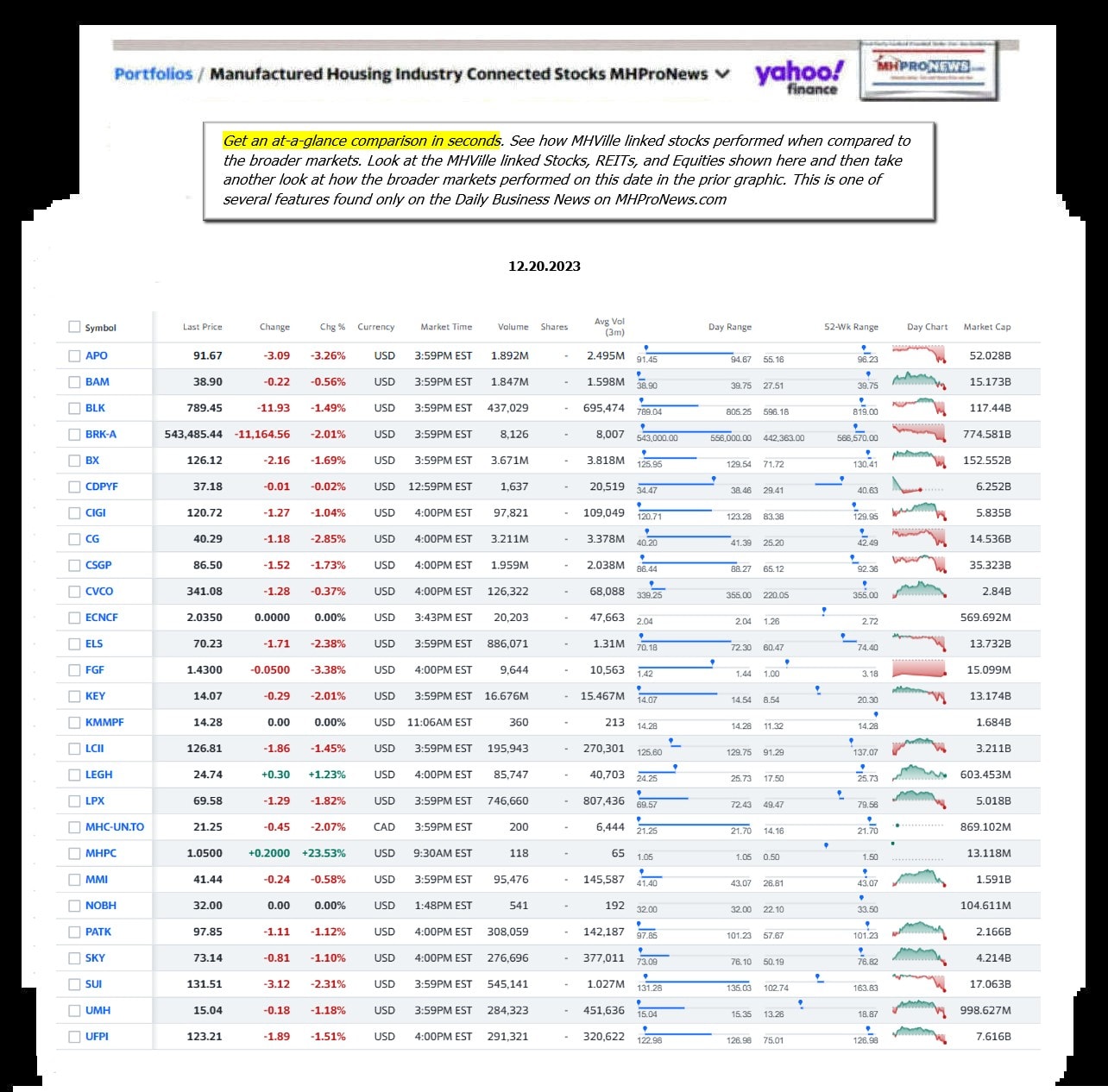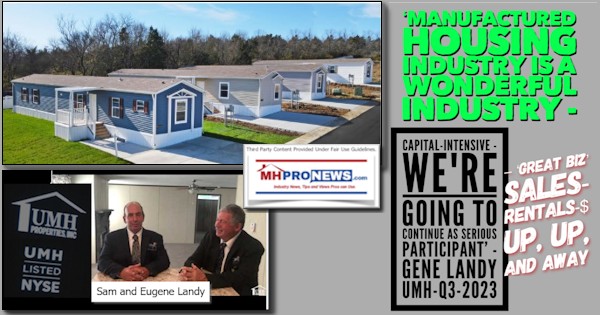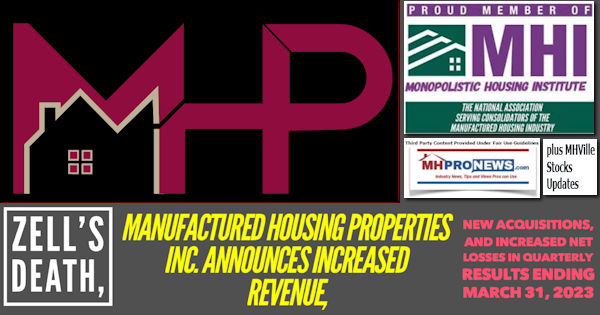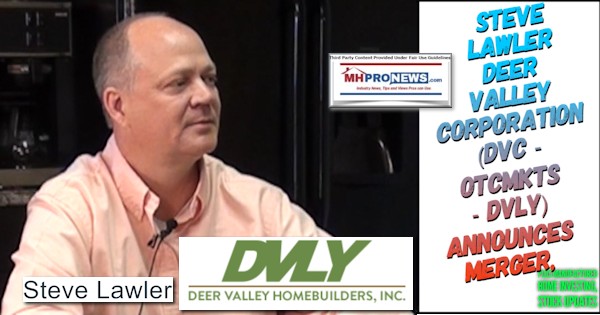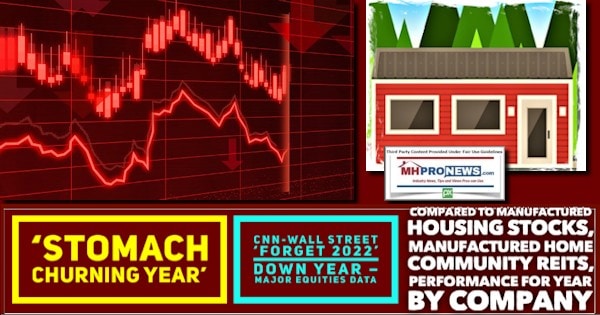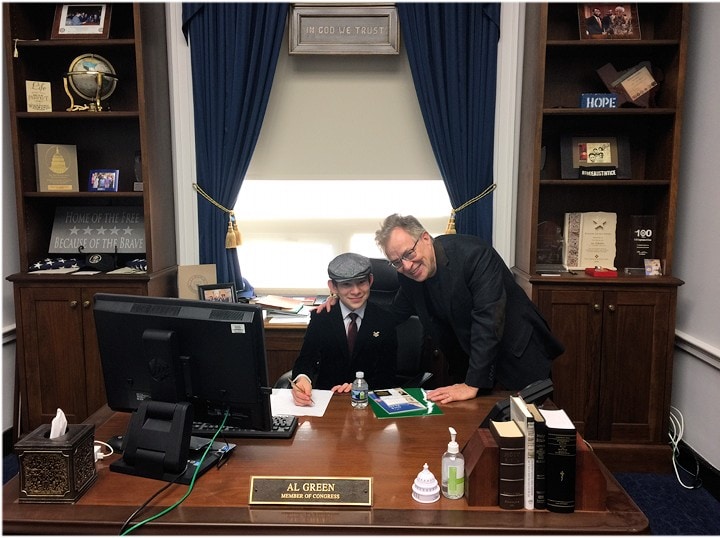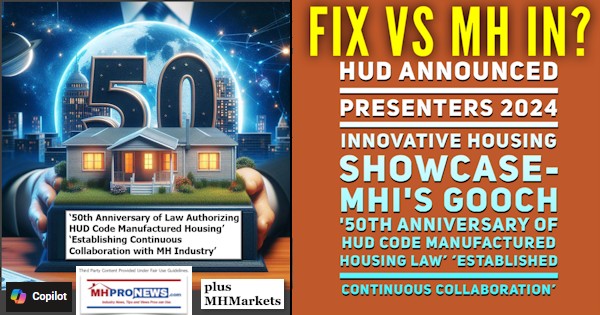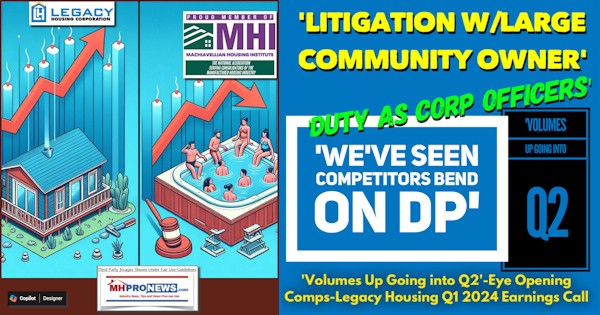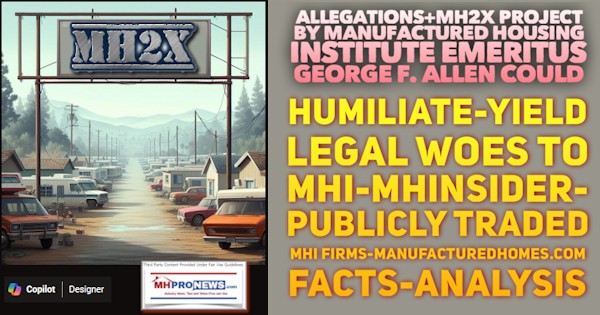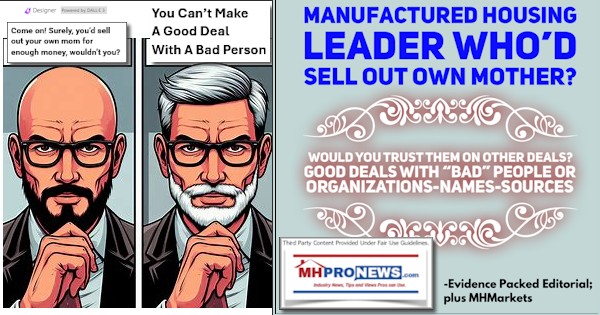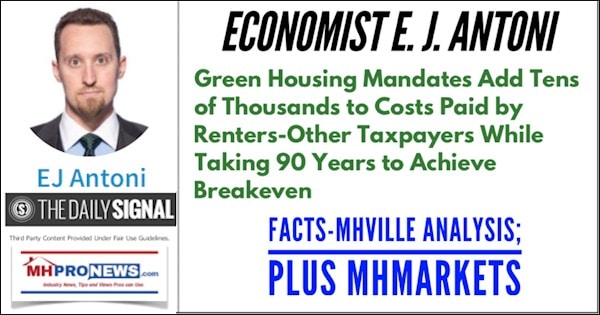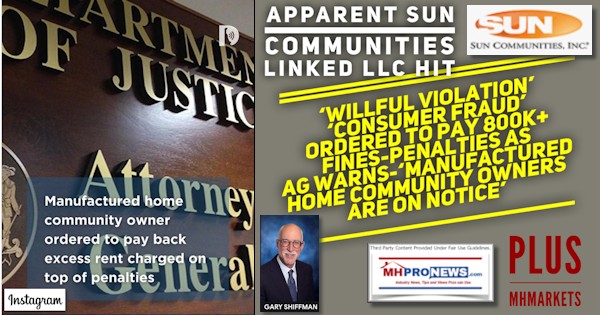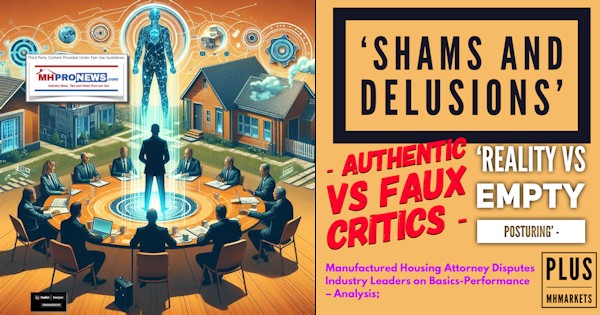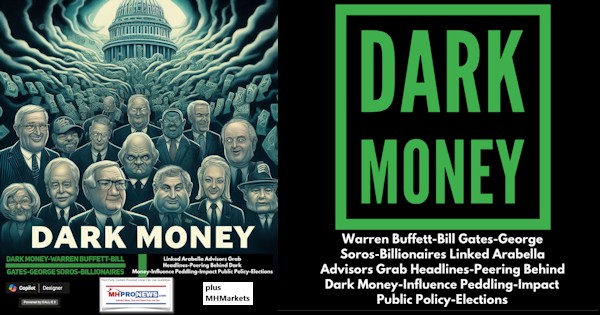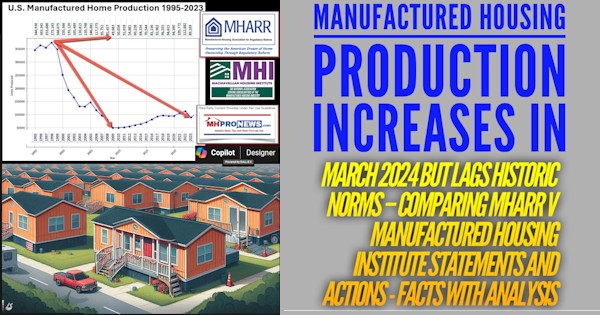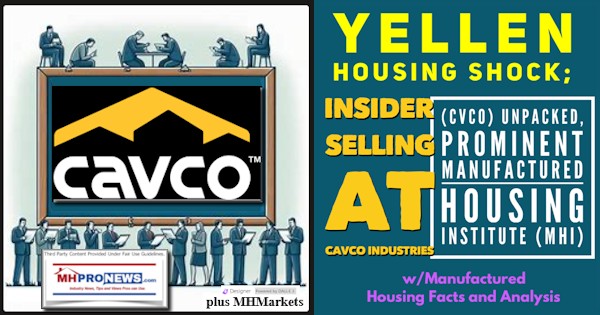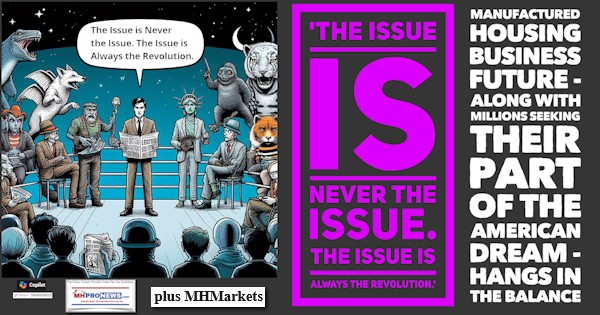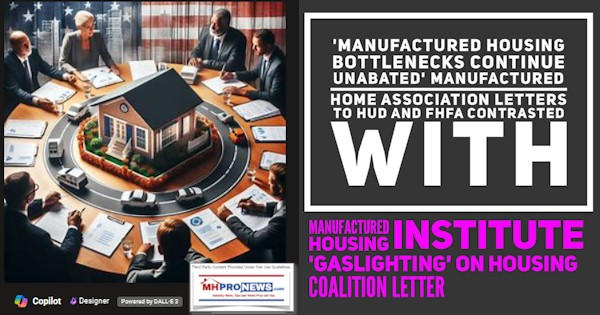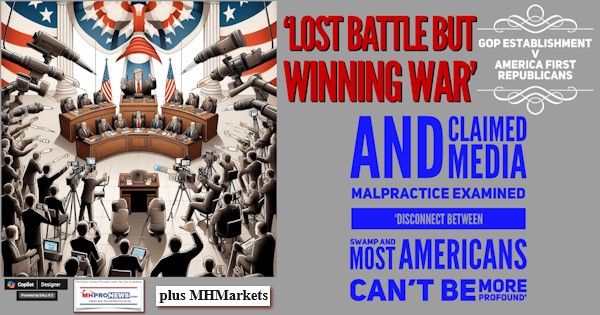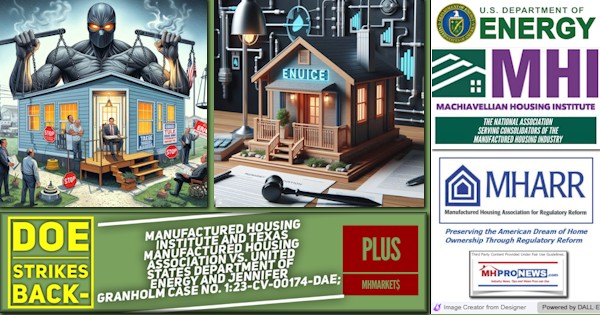
According to Mark Weiss, J.D., the latest Department of Energy motion “…continues DOE’s longstanding track record of Orwellian double-speak regarding this [manufactured housing energy] rule. Out of one side of their mouth, they claim that the May 2022 rule is “final.” Out of the other side, they claim that it really isn’t because the final enforcement procedures aren’t in place yet — and therefore it can’t be adjudicated. They can’t have it both ways. The [DOE manufactured housing energy] rule itself shows that it is wildly cost effective, testing and enforcement costs will only make that ratio worse.” Weiss is the president and CEO of the Manufactured Housing Association for Regulatory Reform (MHARR). Weiss added: “The fact that HUD itself, as the guardian of the manufactured housing program, would engage in such destructive and damaging behavior is unacceptable.”
Weiss-led MHARR recently warned the industry as to just how serious the threat is from the pending implementation of the DOE’s manufactured housing energy rule. Per MHARR, the rule they propose is ‘Stunning and Unworkable’-DOE’s Extreme Energy Enforcement Regulations Would Destroy Affordable Manufactured Homes.
When asked for comments on a topic, there are times that MHARR might be swamped, under various time pressures unable to give a properly considered response to an inquiry from MHProNews. But as the reply above from Weiss to an inquiry from MHProNews reflects, in most cases, one or more officials with MHARR do reply and often swiftly.
By way of contrast, MHProNews asked MHI leaders – including senior staff, corporate board members, and attorneys – on December 7, 2023 for a response to an multifaceted inquiry. The inquiry covered fresh as well as prior issues. MHI leaders were given the opportunity to react or otherwise comment on any item previously published (including this deep dive or this one) by MHLivingNews and MHProNews. Almost two weeks later, no formal response. Yet informed sources tell us that the inquiry was received and circulated.
That should beg the question. Why is it that the larger trade group – MHI – with a much larger budget and far more staff – can’t manage a response to issues that matter to the vast majority of active manufactured housing industry pros, as well as to affordable housing consumers, plus those who have investments in the manufactured home industry? Does the reader see what might motivate a Democratic staffer to tell MHProNews that MHI’s reputation on Capitol Hill is that of an “anti-consumer” trade group?
With that brief preface, more on that and other issues in Part II of today’s report and news analysis. But first, the latest counterattack from the U.S. Department of Energy (DOE) legal team.
Part I: Filed 12/07/23 – No. 1:23-cv-00174-DAE in Manufactured Housing Institute and Texas Manufactured Housing Association vs. United States Department of Energy and Jennifer Granholm Case

DEFENDANTS’ REPLY IN SUPPORT OF THEIR MOTION TO DISMISS INTRODUCTION
By avoiding premature adjudication, the ripeness doctrine prevents courts from entangling themselves in abstract disagreements over administrative policies. Plaintiffs’ challenge to the Energy Conservation Standards for Manufactured Housing Rule (“Standards Rule”) presents such an abstract disagreement. Their claims regarding the costs associated with testing, compliance, and enforcement are predicated upon assumptions about how Defendant Department of Energy (“DOE”) will evaluate compliance and the related costs, even though those costs may never materialize. Indeed, DOE has recently announced a proposed rule regarding compliance and enforcement. Waiting until after DOE completes that rulemaking will enable the Court to resolve those claims in the context of a concrete—not abstract—dispute, thereby significantly advancing the Court’s ability to consider the legal issues those claims present. As such, Plaintiffs’ claims regarding the costs associated with testing, compliance, and enforcement are not currently fit for judicial decision.
Consideration of Plaintiffs’ remaining claims challenging the Standards Rule should similarly be delayed in the interest of judicial economy because the forthcoming final enforcement rule may resolve some of their concerns, thereby narrowing the issues requiring judicial review. Deferring review of Plaintiffs remaining claims will also serve the interests of judicial economy by avoiding piecemeal adjudication, preserving the resources of both the Court and the parties.
Moreover, Plaintiffs concede that their members do not face imminent enforcement and the Standard Rule’s extended compliance dates ensure that Plaintiffs’ members do not need to come into compliance until after DOE promulgates the final enforcement rule. Plaintiffs’ members will thus not suffer hardship in the absence of judicial review. Accordingly, Plaintiffs’ claims are unripe for adjudication and this case should be dismissed.
1
ARGUMENT
- Plaintiffs’ Claims Are Not Fit For Judicial Review
Plaintiffs largely disregard DOE’s arguments, choosing instead to focus on the finality of the Standards Rule. See, e.g., Pls.’ Mem. in Opp’n to Defs.’ Mot. to Dismiss (“Pls.’ Mem.”) at 89, 14-15, ECF No. 50. But DOE never argued that the Standards Rule does not constitute final agency action. See generally Defs.’ Mot. to Dismiss (“Defs.’ Mot.”), ECF No. 49. Rather, DOE argued that Plaintiffs’ claims are not currently fit for judicial review because that review would benefit from a more concrete setting—namely the completion of DOE’s supplemental enforcement rulemaking, which will clarify how the agency will evaluate manufacturer compliance with the standards, set forth procedures for enforcing noncompliance, and address associated costs. See id. at 1-2, 9-12. It is well-settled that claims arising from final agency action are unfit for judicial review if “further factual development would significantly advance [the Court’s] ability to deal with the legal issues presented[.]” Nat’l Park Hospitality Ass’n v. U.S. Dep’t of Interior, 538 U.S.
803, 812 (2003) (citations omitted); see also Walmart, Inc. v. U.S. Dep’t of Justice, 21 F.4th 300, 311 (5th Cir. 2021) (“Failure on even one of the three prongs [courts consider when evaluating fitness for adjudication] can render a case unfit for judicial review.”).
That is precisely the circumstance presented here. Permitting DOE to complete the enforcement rulemaking will significantly advance the Court’s ability to review Plaintiffs’ claims by allowing it to avoid entangling itself in abstract disagreements sparked by Plaintiffs’ speculations about how DOE will evaluate and enforce manufacturer compliance with the standards, as well as the costs associated with those not-yet-promulgated procedures.
Plaintiffs contend that the Court does not need a more concrete setting because “the
Standards Rule has already failed to account for [the] costs” related to “DOE’s forthcoming testing,
2
compliance, and enforcement procedures[.]” Pls.’ Mem. at 14; see also id. at 12. The duct system leakage testing hypothetical highlighted in their First Amended Complaint, Plaintiffs assert,
“merely illustrates the consequences flowing from DOE’s failure.” Id. at 14. Plaintiffs argue that
“[w]hatever the costs may be for duct leakage testing, DOE’s cost-effectiveness analysis from the Standards Rule admittedly fails to incorporate those costs.” Id.
As an initial matter, contrary to Plaintiffs’ contention, the Standards Rule does address the costs associated with demonstrating compliance. DOE stated in the Standards Rule that “many of the requirements” would “require minimal compliance efforts[,]” such as “documenting the use of materials [already] subject to separate Federal or industry standards” and would thus “result in minimal additional costs to manufacturers.” Energy Conservation Program: Energy Conservation Standards for Manufactured Housing, 87 Fed. Reg. 32,728, 32,758 (May 31, 2022). DOE also noted that it would endeavor to ensure in a future action that “manufacturer compliance with the standards” is “not overly burdensome or costly[.]” Id.
In any event, Plaintiffs’ argument underscores, rather than refutes, the speculative nature of their claims related to the costs associated with compliance and enforcement because it presupposes the forthcoming enforcement rule will require duct system leakage testing and thus impose compliance costs beyond the minimal costs contemplated in the Standards Rule. But it is far from certain whether DOE will require duct system leakage testing to demonstrate compliance in the final enforcement rule. Indeed, DOE recently announced its proposed enforcement rule and the proposed rule does not include any specific test procedures to demonstrate compliance with the standards. See DOE, Pre-Publication Copy, Energy Conservation Program: Energy
Conservation Standards for Manufactured Housing; Enforcement, Notice of Proposed
Rulemaking (“Enforcement NOPR”) at 8, 19 (signed Dec. 6, 2023), available at
3
https://www.energy.gov/sites/default/files/2023-12/mh-enforcement-nopr.pdf, attached as Exhibit A. Consistent with its statements in the Standards Rule, DOE is proposing to evaluate compliance by reviewing, upon request, certain records that manufacturers are already required to maintain and provide to the Department of Housing and Urban Development (“HUD”) pursuant to existing
HUD regulations. See Enforcement NOPR at 12-13 (citing 24 C.F.R. part 3282); see also id. at 20-21, 35-36.
Accordingly, postponing review of Plaintiffs’ claims regarding the costs associated with testing, compliance, and enforcement until after DOE completes the enforcement rulemaking will solidify the factual context of the dispute between the parties, which will significantly advance the
Court’s ability to resolve the legal issues those claims present. See Nat’l Park Hospitality Ass’n, 538 U.S. at 812. As it stands now, an actual controversy does not exist given the assumptions upon which Plaintiffs’ claims are predicated may not materialize. See Texas v. United States, 523 U.S. 296, 300 (1998) (“A claim is not ripe for adjudication if it rests upon ‘contingent future events that may not occur as anticipated, or indeed may not occur at all.’”) (citation omitted).
Although Plaintiffs correctly observe that Defendants do not contend that resolution of
Plaintiffs’ other claims would benefit from a more concrete setting, see Pls.’ Mem. at 13-14, Defendants explained in their opening memorandum that permitting DOE to complete the enforcement rulemaking before considering all of Plaintiffs’ claims serves the interests of judicial economy because the final enforcement rule may resolve some of Plaintiffs’ concerns, which would narrow the issues requiring review, see Defs.’ Mot. at 11. The recently announced proposed enforcement rule exemplifies this point: Plaintiffs claim that DOE failed to “account for actual market conditions” and thus failed to consider whether the Standards Rule “will too greatly impact the purchase price of manufactured housing[.]” Pls.’ First Am. Compl. Seeking Permanent
4
Declaratory & Injunctive Relief Under the APA ¶¶ 79, 123, ECF No. 48; see also id. ¶ 115. They provide several examples of DOE’s purported failures, including the adoption of Manual S for equipment sizing. See id. ¶ 89 (asserting the adoption of Manual S “severely restricts current sales practices”). In the proposed enforcement rule, however, DOE proposes to clarify the equipment sizing requirement by permitting manufacturers to use either Manual S or the approach codified in HUD’s regulations. See Enforcement NOPR at 9-10, 35. If the final enforcement rule includes DOE’s proposed clarification, Plaintiffs’ concerns regarding Manual S will be resolved, thereby eliminating an issue requiring judicial review.
Defendants also explained that postponing consideration of Plaintiffs’ claims until after DOE has promulgated the final enforcement rule serves the interests of judicial economy by avoiding piecemeal adjudication. See Defs.’ Mot. at 11-12. Plaintiffs counter that the “interests of judicial economy cannot justify deferring review of an otherwise ripe challenge[.]” Pls.’ Mem. at 15. This argument ignores that Plaintiffs’ claims regarding the costs associated with testing, compliance, and enforcement are speculative and thus not ripe for adjudication. Reviewing Plaintiffs’ remaining claims now, before DOE completes its enforcement rulemaking, would potentially result in the Court having to consider the validity of the Standards Rule multiple times, particularly if Defendants were to prevail on the remaining claims and/or Plaintiffs challenge the supplemental provisions promulgated in the enforcement rule. The Fifth Circuit has long disfavored such “piecemeal judicial review” because it “contravene[s] sound policies favoring judicial and administrative economy.” Pennzoil Co. v. FERC, 742 F.2d 242, 245 (5th Cir. 1984).
Plaintiffs offer no sound reason why the Court should decline to apply those policies here.
Finally, relying on Wyoming v. Zinke, 871 F.3d 1133, 1142 (10th Cir. 2017), Plaintiffs contend the ripeness doctrine is inapplicable because “[s]ubsequent agency action[,]” only
5
“render[s] a challenge to a final rule unripe” if the subsequent action presents “unusual circumstances[,]” meaning a “‘clearly expressed’ intention to rescind” or revise “the rule.” Pls.’
Mem. at 9-10 (quoting Zinke, 871 F.3d at 1142). Plaintiffs argue that because DOE has not
“committed to revising or rescinding the Standards Rule,” the “Delay Rule does not present the ‘unusual circumstances’ necessary to render Plaintiffs’ challenges unfit for review.” Pls.’ Mem. at 10. Plaintiffs’ reliance on Zinke is misplaced. “Unusual circumstances” are not limited to an agency’s expressed intention to rescind or revise a challenged rule. The Tenth Circuit made clear that the Bureau of Land Management’s proposed rule to rescind the challenged rule rendered the appeal unfit for judicial review because the matter in dispute “rest[ed] upon contingent future events that may not occur as anticipated, or . . . may not occur at all” and thus had become a
“moving target.” Zinke, 871 F.3d at 1142 (citation omitted); cf. Ohio Forestry Ass’n v. Sierra Club, 523 U.S. 726, 735-36 (1998) (noting possibility that agency may take further action to refine its land and resource management plan, including “modify[ing] the expected methods of implementation,” and observing that “review now[,]” without the benefit of a focused logging proposal, “may turn out to have been unnecessary”) (emphasis added). Given Plaintiffs’ claims regarding the costs associated with testing, compliance, and enforcement likewise rest upon contingent future events that may not occur as anticipated, see supra at 3-4, the claims, like the appeal in Zinke, are a moving target. Therefore, contrary to Plaintiffs’ contention, those claims do present an “unusual circumstance” that render them unfit for judicial review.
Because Plaintiffs’ claims regarding the costs associated with testing, compliance, and enforcement are unfit for judicial review, and postponing review of their remaining claims would serve the interests of judicial economy, the Court should end its inquiry here and dismiss Plaintiffs’
6
action as unripe. See Huawei Techs. USA, Inc. v. FCC, 2 F.4th 421, 435 n.30 (5th Cir. 2021)
(“Unsuitability for review is determinative.”).
- Plaintiffs’ Members Will Not Suffer Hardship Absent Judicial Review
Even if the Court were to consider the hardship prong of the ripeness inquiry, Plaintiffs have not demonstrated that their members will suffer hardship if the Court were to delay review of their claims. Indeed, Plaintiffs concede that their members do not face imminent enforcement of the standards. Pls.’ Mem. at 18. Nonetheless, relying on National Propane Gas Association v. United States Department of Transportation, 43 F. Supp. 2d 665 (N.D. Tex. 1999), Plaintiffs argue that because the Standards Rule remains in effect and “DOE expects manufacturers to begin modifying their behavior,” their members will suffer hardship in the absence of judicial review because they “need to alter their day-to-day operations to avoid future penalties.” Pls.’ Mem. at 17-18 (citing Nat’l Propane Gas Ass’n, 43 F. Supp. 2d at 675).
Neither the Standards Rule nor the Delay Rule, however, require manufacturers to take steps to alter their operations until the final enforcement rule has been promulgated. The amended compliance dates set forth in the Delay Rule—60 days after publication of the final enforcement rule for Tier 1 homes and July 1, 2025, for Tier 2 homes—ensure that manufacturers will have time to modify their operations after DOE has clarified how it will evaluate compliance. DOE’s expectation, therefore, is that manufacturers’ decisions regarding what steps they will need to take to comply with the standards will be informed by the final enforcement rule. See Energy
Conservation Program: Energy Conservation Standards for Manufactured Housing; Extension of Compliance Date, 88 Fed. Reg. 34,411, 34,413 (May 30, 2023) (“Delaying the compliance date until after the enforcement procedures are issued provides manufacturers time to understand
7
DOE’s enforcement procedures and prepare their operations to ensure compliance with DOE’s standards.”).
As such, this matter is distinguishable from National Propane Gas Association. There, Congress enacted legislation that prohibited the Department of Transportation from using appropriated funds to enforce the challenged rule. Nat’l Propane Gas Ass’n, 43 F. Supp. 2d at 674. Notwithstanding the apparent bar on enforcement imposed by Congress, the district court concluded the plaintiffs would suffer hardship in the absence of judicial review because the challenged rule remained in effect, the Department of Transportation “expect[ed] and intend[ed] immediate compliance” with the regulations, and, as a result, the “regulations ha[d] a direct and immediate impact on the day-to-day affairs of [the] plaintiffs.” Id. at 675. Those circumstances are not present here. Although the Standards Rule does remain in effect, DOE’s decision to delay compliance coupled with its acknowledgment that the delay will afford manufacturers an opportunity to understand the enforcement procedures before compliance with the standards is required demonstrates that the Standards Rule does not have a “direct and immediate impact on the day-to-day affairs” of Plaintiffs’ members. Id.; see also Roman Cath. Diocese of Dall. v. Sebelius, 927 F. Supp. 2d 406, 426-27 (N.D. Tex. 2013) (concluding that plaintiff’s inability to “sufficiently plan its compliance with the regulations in that it will have inadequate time to make effective decisions” does not constitute a hardship warranting judicial review).
Plaintiffs also argue that delaying review of their claims would impose “substantial hardship” because it would be “a practical impossibility” to refile and prosecute this case before their members would have to comply with the Tier 1 standards, particularity given Defendants’ prior position that Section 705 of the Administrative Procedure Act does not provide the Court with authority to stay the compliance date. Pls.’ Mem. at 18-19. But this argument rings hollow.
8
Plaintiffs may, like any other litigant, seek relief once DOE promulgates the final enforcement rule, irrespective of Defendants’ prior litigation position, should the final enforcement rule not resolve their concerns about the Standards Rule. Their members will also be able to raise their claims if, after compliance is required, “enforcement is initiated.” Roman Cath. Diocese of Dall., 927 F. Supp. 2d at 427. Accordingly, Plaintiffs’ members will not suffer hardship by delaying judicial consideration of their claims until after DOE promulgates the final enforcement rule.
CONCLUSION
For these reasons, as well as the reasons set forth in Defendants’ opening memorandum, Plaintiffs’ challenge to the Standards Rule is not ripe for adjudication. The Court should accordingly grant Defendants’ motion and dismiss Plaintiffs’ First Amended Complaint for lack of subject matter jurisdiction.
Dated: December 7, 2023
BRIAN M. BOYNTON
Principal Deputy Assistant Attorney General
BRAD P. ROSENBERG
Special Counsel
/s/ Kristina A. Wolfe
KRISTINA A. WOLFE (VA Bar No. 71570)
Senior Trial Counsel
U.S. Department of Justice
Civil Division, Federal Programs Branch
P.O. Box 883, Ben Franklin Station
Washington, DC 20044
Tel: (202) 353-4519; Fax: (202) 616-8470 …##
MHProNews editorial notice. The PDF of the above is found at this link here. If there is any distortion in page count or otherwise caused by ‘cutting and pasting’ the content of the DOE pleading into this publishing software, the PDF should be considered the authoritative source.
Part II – Additional Information with More MHProNews Analysis and Commentary in Brief
To MHARR’s Mark Weiss’ point that the DOE is talking out of both sides of its mouth, their attorneys claimed in their pleadings above that: “Accordingly, Plaintiffs’ members will not suffer hardship by delaying judicial consideration of their claims until after DOE promulgates the final enforcement rule.” Apparently, DOE felt no need to mention that it isn’t just MHARR’s Mark Weiss, but MHI-TMHA’s attorneys that said in a prior pleading that the industry would suffer “irreparable harm” if this rule goes into effect. There is a wide gap between no harm and “irreparable harm.”
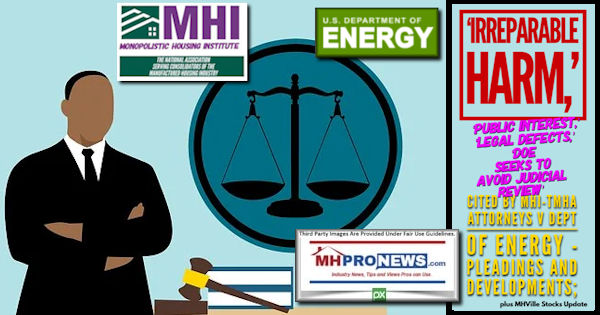
In years gone by, replies from MHI leaders to this platform were swift and often thankful. While MHI’s leaders haven’t bothered to reply to the apparently largest professional audience in the manufactured housing industry, a slight that is arguably aimed at impacting both our readers and us, perhaps from their perspective, there is little else that they can do? How can MHI respond to an ever-growing array of facts, evidence, and applied commonsense analysis that documents the various disconnects between what MHI leaders have said and other remarks and/or actions that may reflect the opposite of what they have claimed?
The latest inquiry from MHProNews to MHI’s leaders and attorneys makes clear that they are invited to respond to any article, past or future on any issue. Longtime readers will recall that MHI at various times paid for content to be placed on our website. They apparently respected the fact that they could access a larger audience than their own.
As a focused and relevant segue, circa 2017, several apparent pivots occurred. They included MHI connected organizations barring this writer and our team from attending industry events, in apparent violations of our rights. Those included events that we were previously paid to help promote, because – as noted – there is apparently no other trade publication that has the reach that ours does. That has been confirmed by an MHI member advertiser who said they used ‘all’ of the alternative trade media and said that ours was the runaway most effective. That too suggests what our site metrics and other sources tell us about our audience size. As we periodically note, in the past year, our traffic has roughly doubled, though the number of pages per visit is down from a year ago. Nevertheless, our pageviews are significantly higher than giant mainstream news platforms such as CNN or Fox News. Note that while Fox dominates in viewership in cable, CNN has a vast online audience for their digitally published content, as does Fox. Even with our surge in readership and a resulting dip in pageviews per visit, our site metrics tell us that there is roughly double, sometimes more, page views per visit on MHProNews than vs. CNN or Fox. Because of how rivals digital news content is structured as a subset of a larger website, a source like SimilarWeb can’t provide specific metrics to measure their visitor engagement. But other evidence has indicated that they are not only de facto organs for MHI’s purported paltering, posturing, and propaganda, but they are also a tiny fraction of our audience.
That’s not vanity, that’s significant. It should be obvious that industry professionals know the difference between rising and falling sales. There is only so much gaslighting that can be done by MHI’s circle of influence.
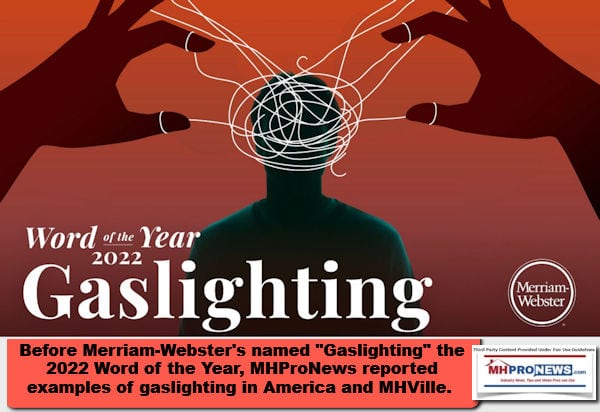
The hard data in manufactured housing IS measurable. It reflects that manufactured housing began a steep decline a year ago. Pay close attention to the bottom orange call out box below. The report with the most recent national data and analysis follows that graphic.
Note: to expand this image below to a larger or full size, see the instructions
below the graphic below or click the image and follow the prompts.
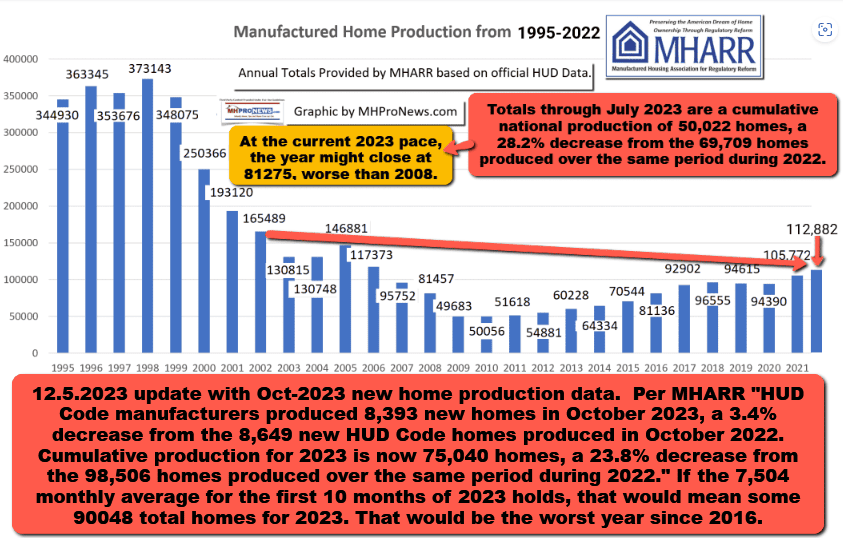
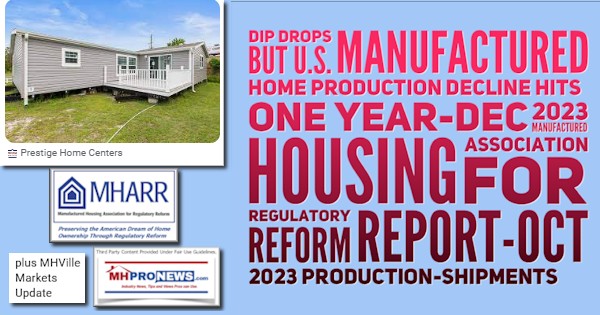
No one factor can be blamed for everything that has occurred in manufactured housing in the 21st century. That said, are there factors that have more impact than others? Yes. Zoning and finance are widely acknowledged in and beyond our industry’s professionals as a limitation. From earlier in 2023, consider the published thoughts of attorney Andrew Justus. His views were provided and then unpacked by MHProNews as but one of several such indications of what has gone wrong in the 21st century for the sales and production growth-minded professionals in our industry.
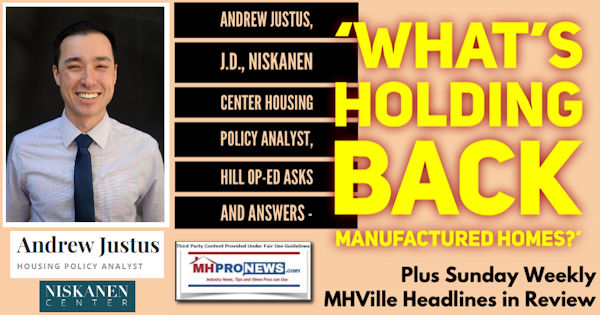
A recent caller to MHProNews bluntly said that if MHARR and MHProNews had not hammered away at MHI to sue DOE to get their manufactured housing energy rule stopped via litigation, there was no evidence that MHI was planning to sue the DOE. More on that here in this article.
This linked Q&A by MHProNews with MHARR’s Danny Ghorbani and published on their website appears to be the most comprehensive look at the history of MHI with respect to their so-called efforts on the DOE energy rule process. It would be a fair observation to say that MHARR members broadly seek profitable organic growth. This linked search of the MHARR website yields the array of information and articles published by them on their platform that keeps industry readers, and other parties, informed about what is occurring in MHVille on the DOE energy rule topic.
Compare and Contrast MHARR and MHI on the DOE Energy Rule
In a matter of a few minutes, someone can quickly and accurately compare and contrast the dozens of articles by MHARR on their website with what is publicly available from MHI on their website on the DOE energy rule. Notice that the search phrase used in both cases is the same. The difference is stark. Keep in mind that MHI is larger, has more staff, many times the budget, and near the end of the summer of 2023 updated their website. It is obvious from even a scan of pages of items from MHARR vs. what MHI offers that MHARR has far more content, the vast majority of which is made publicly available.
On this date, MHI has no – zero – content available to the public on the “DOE energy” search of their website.
That begs the question. Why is MHI hiding what limited content it has available behind a “member only” login/paywall? Again, let’s stress that the underlying legislation for this rule has existed since 2007, and that it has been MHARR’s efforts – not MHI’s – that has kept the “destructive” and “costly” DOE rule from going into effect years ago. More on that here in this article.
It doesn’t take a genius to realize that MHARR apparently believes that informing the industry’s readers – and other interested parties – of what is and isn’t occurring with respect to the DOE energy rule matters. Nor does it take a genius to realize that MHI seems to believe that less information and information that is from their perspective as controlled as possible matters. Nor is that merely deductive reasoning. Recall that MHI hired an outside firm to control their message on the DOE energy rule.
Quoting an MHI email.

Let’s sum up some key points.
MHARR has pointedly accused MHI leaders of previously – and apparently secretly – negotiating with DOE to obtain an agreed upon energy rule. MHI is still asking for a different energy rule than what DOE is proposing. Documents obtained from DOE under a FOIA request demonstrate that MHI was working with some of the same organizations that MHARR calls ‘energy interests’ to create a new energy rule. Yet MHI admits in various statements, and through their attorneys, that the pending DOE energy rule could cause “irreparable harm” to the manufactured home industry.
An MHI email (not found on their website) dated February 16, 2023 says in part:
“In an effort to ensure a consistent industry message, we ask that you please refrain from making comments to reporters on this matter and instead refer any media inquiries to Molly Boyle. Molly’s email is molly.boyle@fpmgi.com and her phone # is 202-777-3668.”
MHI asked that anyone, member or nonmember, refer any reporter’s inquiries to Molly Boyle at FPMGI.com regarding the DOE energy rule.
See the screen capture of the search of MHI’s website for “DOE energy” at this link here. Then compare it to the results for the identical search phrase on the MHARR website linked here. MHI has openly admitted via email that they want to control their message. MHARR apparently wants the widest possible access to their insights on the DOE energy rule. Who is it that has something to hide between those two national trades manufactured housing trade associations?
What could MHI’s motivation be? See the report linked below.
MHARR made it clear. The only outcome that makes sense is that MHI seek to “kill” the DOE energy rule, not merely tweak it. More on this and other manufactured housing industry related topics in the days ahead. ##
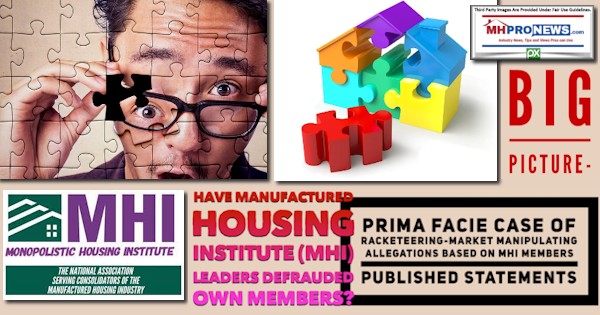
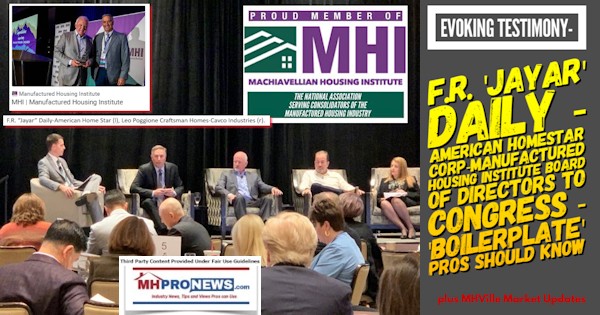
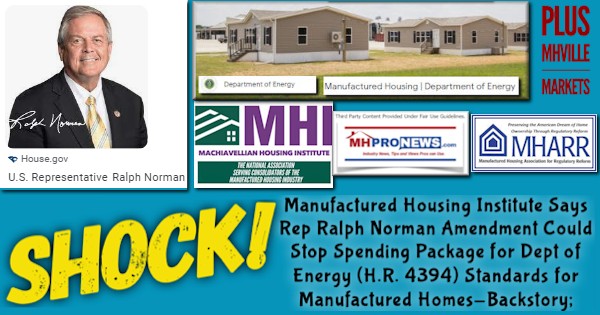
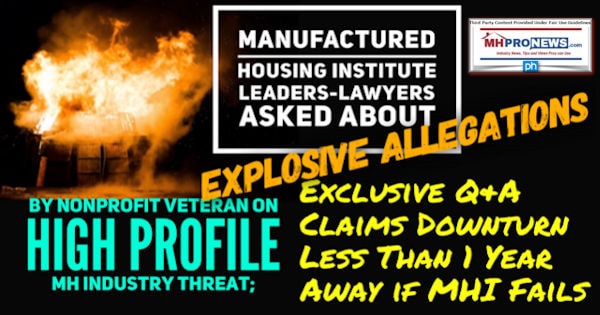
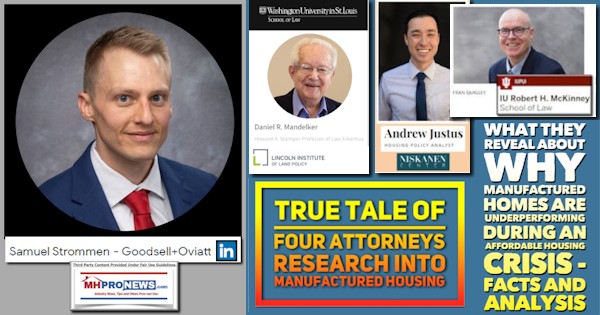

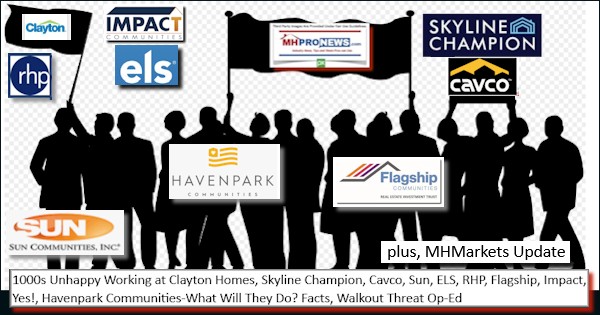

PS: IMHO, MHARR appears to be more focused on the bottom-line outcome of getting MHI to do the right thing now, given their history on the DOE energy rule matter.
Part III – is our Daily Business News on MHProNews stock market recap which features our business-daily at-a-glance update of over 2 dozen manufactured housing industry stocks.
This segment of the Daily Business News on MHProNews is the recap of yesterday evening’s market report, so that investors can see at glance the type of topics may have influenced other investors. Thus, our format includes our signature left (CNN Business) and right (Newsmax) ‘market moving’ headlines.
The macro market move graphics below provide context and comparisons for those invested in or tracking manufactured housing connected equities. Meaning, you can see ‘at a glance’ how manufactured housing connected firms do compared to other segments of the broader equities market.
In minutes a day readers can get a good sense of significant or major events while keeping up with the trends that are impacting manufactured housing connected investing.
Reminder: several of the graphics on MHProNews can be opened into a larger size. For instance: click the image and follow the prompts in your browser or device to OPEN In a New Window. Then, in several browsers/devices you can click the image and increase the size. Use the ‘x out’ (close window) escape or back key to return.
Headlines from left-of-center CNN Business – from the morning of 12.20.2023
